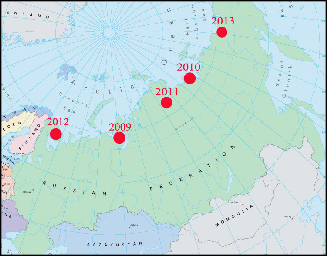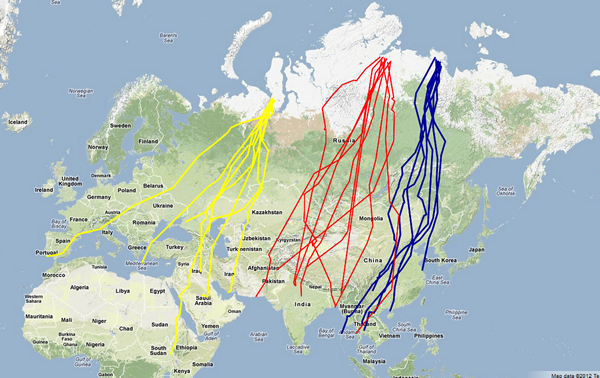
Project Outline
- We work in a different study area each year, tagging up to 10 birds in each study area.
- We measure different morphological parameters and photograph each trapped bird in order to compare the appearance of Peregrines across different areas of the Eurasian Arctic.
- We collect basic ecological data in each study area, including nearest neighbour distances and information on diet, breeding ecology and habitat characteristics of nesting territories.
- We fit Argos satellite transmitters to each trapped bird (up to 10 per study area).
- Argos satellite tracking data is used to study home range use by breeding Peregrines in relation to nesting phenology and habitat characteristics of the nesting territory. Satellite data is used to determine the timing and migration routes of Peregrines from their breeding areas to the wintering areas and back. Data is also used to study the winter ranging behaviour of individual Peregrines.
- We collect feathers and/or blood from up to 10 unrelated individuals in each study area to be used as a source of DNA.
- DNA from unrelated individuals will be used to determine if there are any genetic differences between different breeding populations of Peregrines across the Eurasian arctic.
Preliminary conclusions from programme
1.The Peregrine breeding populations in the three areas surveyed to date (Yamal Peninsula, Lena Delta and Eastern Taimyr) are healthy with no indication of a decline. In the tundra zones and river channels of each study area most suitable nesting areas were occupied by breeding pairs.
2. In the tundra zone of Northern Siberia Peregrines have an abundant prey supply, where they feed mainly on waders, waterfowl, seabirds and passerines.
3. Migration pathways show that Peregrines in Northern Siberia exhibit a pattern of parallel migration with some degree of connectivity between breeding and wintering populations. The pattern of parallel migration indicates how gene flow across Northern Eurasia can be limited and explains how the clinal variation size and plumage characters can be maintained.
4. The migration pathways indicate that Peregrines tend to avoid large sea crossings, which does indicate that some channelling of autumn migration can occur in coastal areas such as along the northern Black Sea coast and along the coasts of Caspian Sea, Red Sea and the Arabian Gulf.
5. Factors that determine the direction and distance of migration are not known but undoubtedly involve both a genetic and environmental component.
6. The wide range of wintering destinations and migration routes buffers the Peregrine from environmental problems in specific geographical locations. Consequently, only wide-ranging environmental problems (such as the previous impact of agricultural pesticides) are likely to have a major impact on Peregrine populations.
7. Major environmental changes in their Arctic breeding range, possibly as a result of global climate change, has the potential to affect Peregrines (perhaps by influencing population trends and/or migratory behaviour).
2011 – Autumn Migration pathways and wintering areas of peregrines from the Yamal Peninsula, Lena Delta and Eastern Taimyr

Taken from Dixon et al. 2012. Falco 39, p 4-9
